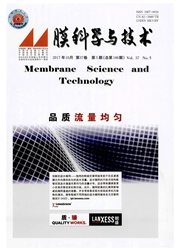

 中文摘要:
中文摘要:
为了研究磷酰胆碱类聚合物的生物相容性,以偶氮二异丁腈(AIBN)为引发剂,采用自由基聚合制备了系列2-甲基丙烯酰氧乙基磷酰胆碱(MPC)与甲基丙烯酸丁酯(BMA)、甲基丙烯酸异辛酯(EHMA)的共聚物PMB、PMEH.用红外光谱、元素分析、核磁共振等方法对其结构进行了表征并探讨了其在不同溶剂中的溶解性,为该类物质的提纯提供依据;通过溶剂挥发法制备了共聚物薄膜,血小板黏附实验显示,含有MPC的聚合物薄膜比不含MPC的聚合物薄膜有更好的血液相容性;溶胀度测试显示MPC聚合物薄膜有非常好的吸收水的能力,且平衡含水量(EwC)会随着MPC在聚合物薄膜中含量的增加而增加,当MPC在PMB20中的摩尔含量为18%时,平衡含水量可以达到47%,这是磷酰胆碱类聚合物薄膜具有优良生物相容性的原因之一.
 英文摘要:
英文摘要:
2-methacryloyloxyethyl phosphorylcholine (MPC) was copolymerized with butyl methacrylate (BMA) and 2-ethylhexyl methacrylate (EHMA), respectively, using 2, 21-azodiisobutyronitrile (AIBN) as the initiator, in order to research the biocompatibility of the phosphorylcholine polymers. The chemical structures of the polymers were characterized by the IR, 1H-NMR and elemental analyses. The solubility of the polymers in different solvents was also lnvestlgateo, wnlcn proxuwueu r Of these polymers. Polymer membranes were prepared by solvent evaporation method. The platelet rich plasma (PRP) contact studies showed that the adhesion of platelets on the surfaces of MPC polymer membranes was reduced compared to the polymers without MPC unit, which showed good blood compatibility. The equilibrium water content (EWC) of the MPC polymer membranes increased with increases in the MPC mole fraction, and this valae for PMB20 polymer membrane (MPC mole fraction: 18%) reached 47%. The high water content oi phosphorylcholine polymers is one of the reasons for the good biocompatibility of the membranes.
 同期刊论文项目
同期刊论文项目
 同项目期刊论文
同项目期刊论文
 Synthesis of poly(aminopropyl/methyl)silsesquioxane particles as effective Cu(II) and Pb(II) adsorbe
Synthesis of poly(aminopropyl/methyl)silsesquioxane particles as effective Cu(II) and Pb(II) adsorbe 期刊信息
期刊信息
